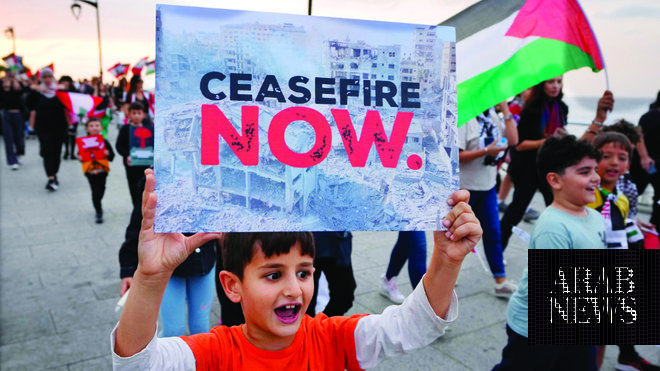
On Salah al-Din, the broad main highway that runs along the Gaza Strip, the trickle of those fleeing on foot from Israel’s war against Hamas has become a torrent, with about 15,000 people attempting to make the perilous journey on Wednesday.
Under white flags, and carrying a few possessions mainly in carrier bags, exhausted parents led their children on Wednesday or carried them under the watch of Israeli tanks as the sounds of war rang out in the near distance.
On Sunday, 2,000 people took the opportunity to flee south during a daily four-hour window announced by the Israel Defence Forces. On Monday it was 5,000.
By Tuesday the daily column trudging south had swelled to 15,000, according to the United Nations, moving towards an area offering a haven of only marginally more safety as Israeli strikes continued to hit locations in the south of Gaza.
On Wednesday the scale of the movement prompted the IDF to extend the period of the “safe corridor” by an extra hour “in reaction to [Palestinians] sizeable response” to Israel’s call for them to use the corridor to flee.
Those fleeing include children, older people and people with disabilities, and most walked with minimal belongings, the UN agency said.
Many of those on the road had started their journey earlier in the day in areas such as Gaza City’s al-Rimal, gathering in family groups or with neighbours to begin their walk, with some saying they had to cross Israeli checkpoints, where they saw people being arrested.
Clutching one of her toddlers, Amira al-Sakani told AFP she fled Gaza City after coming across the airdropped Israeli flyers.
“Our life is tragic,” she said. “We don’t want war. We want peace.”
Ameer Ghalban, who pushed an older relative in a wheelchair, said the two of them had each lived off one piece of bread a day for the past three days. “The majority of people have left their land because the siege has become absolute in Gaza. We have no water, no electricity, and no flour.”
“We don’t know where we’re going,” Naseem al-Dada, carrying one of his children, told the BBC, with the sound of a drone audible overhead. “We’re heading south as they told us to do. We are walking and we don’t know where we’ll go. To the [UN] schools? To sleep on the streets. To sleep at someone’s house? God only knows.”
With numbers on the road on Wednesday estimated to be similar to Tuesday, reports suggested some of those escaping south had been driven out of al-Shati refugee camp on the coast, on the very frontline of the Israeli advance.
From there they had tried to find shelter first at the overcrowded Dar al-Shifa hospital before deciding to keep moving farther south, with video showing large numbers walking through the streets of a Gaza City empty of cars.
Hamas indicated it was opposed to the ongoing evacuation, accusing the UN of colluding with the Israeli military in the “forced displacement” of residents of Gaza.
“UNRWA [the UN’s Palestinian refugee agency] and its officials bear responsibility for this humanitarian catastrophe, in particular the residents of the Gaza [City] area and north of it,” said Salama Maruf, head of the media bureau of Hamas.
While many Palestinians escaped earlier in the war, those taking to the roads now account for about 350,000 people trapped within the Israeli cauldron, battered by intense and continuous daily airstrikes and tank and other fire that have crept closer as Israeli forces have advanced.
In a video clip released by the IDF, the procession of those fleeing can be seen moving through a sandy landscape bordered by war-damaged buildings.
Against a background rumble of motors from the watching armoured vehicles, shots and booms are audible.
Moving quickly in sight of the Israeli guns, some glancing anxiously across, many had hands raised in the air, or held up T-shirts, sheets and pillow cases as makeshift white flags, conscious that others who have fled along this road have been killed in unclear circumstances.
The International Committee of the Red Cross (ICRC), which said one of its humanitarian convoys in Gaza was hit by gunfire on Tuesday, demanded an end to the suffering of civilians.
The ICRC’s president, Mirjana Spoljaric, said: “Children have been ripped from their families and held hostage. In Gaza, ICRC surgeons treat toddlers whose skin is charred from widespread burns.”
What they are escaping from was described in graphic terms on Wednesday by the ICRC’s spokesperson, Alyona Synenko, in Jerusalem. “There are civilians in the north and in Gaza City. They are people who don’t have food, access to basic necessities and, most importantly, who can’t find any place to be safe. We can’t just ignore these people.
“They are still there and they urgently need humanitarian assistance. Making sure there is humanitarian space so people can receive essential supplies is also an obligation under international humanitarian law,” said Synenko.
The UN’s main humanitarian office painted an equally desperate picture, with no bakeries operating in northern Gaza after looting of the last three remaining.
Tens of thousands of others still remain inside the encircled area, many sheltering at hospitals or UN schools, including at Gaza City’s main al-Shifa hospital, where Um Haitham Hejela was sheltering with her young children in an improvised tent.
“The situation is getting worse day after day,” she told Reuters. “There is no food, no water. When my son goes to pick up water, he queues for three or four hours in the line. They struck bakeries, we don’t have bread.”
The north has been without running water for weeks, and the UN aid office said the last functioning bakeries shut down on Tuesday for lack of fuel, water and flour.
Majed Haroun, who lives in Gaza City, said women and children go door to door asking for food, while those in shelters rely on local donations.
The situation for those fleeing, however, is only little better in the south, where hundreds of thousands of displaced people are packed into makeshift shelters including one where, according to the UN, 600 people must share a single toilet.
On Wednesday an Israeli air raid targeted the eastern side of Khan Younis in al-Zana, destroying a home and killing four people, one a little girl.










